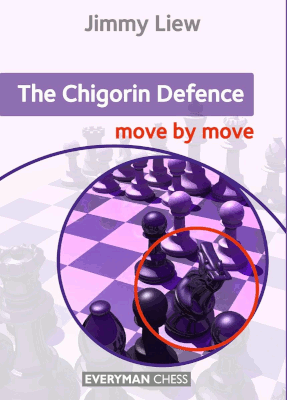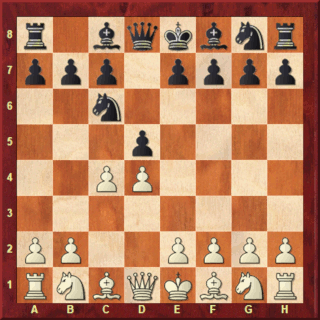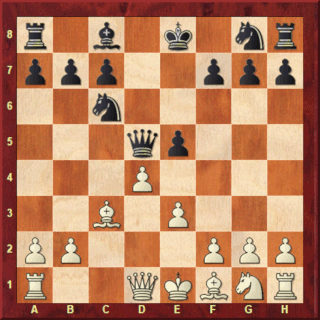The Chigorin Defence: Move by Move, by Jimmy Liew, Everyman Press, ISBN 9781781944257, 336pp, Paperback $29.95, eBook $19.95

The Chigorin Defence is an often underestimated and interesting opening choice for Black versus d4. Although Black blocks the c-pawn, classically a positional mistake in Queen Pawn openings, he aims for a different pawn break and a different, more dynamic type of game. In fact, this opening mirrors the Veresov for White; books for these two openings have both been written by author Jimmy Liew. Mr. Liew is an International Master from Malaysia.
The back cover describes the book, capturing the spirit of the opening well:
“The Chigorin Defence (1 d4 d5 2 c4 Nc6) is a dynamic and provocative response to White’s 1 d4. Rather than set out a defensive stall with systems based on moves such as …e6 and …c6, Black prefers to initiate immediate piece play in the centre. The benefits of this strategy are that Black’s queenside pieces, which are often difficult to develop in the Queen’s Gambit, participate in the struggle at once. The queen’s knight emerges immediately onto an active square and path path is left open for the c8-bishop to develop freely. Naturally there are also drawbacks as Black will not find it easy to establish a foothold in the centre in the early play.
The Chigorin is a perfect counterattacking weapon and will appeal to player who like to throw opponents onto their own resources at an early stage. Jimmy Liew identifies and analyses the precise moments when specific theoretical knowledge is required and also discusses plans and strategies in the quieter variations.”
This book features sixty-one complete games in the chosen lines all stemming from 1.d4 d5 2.c4 Nc6.
 [FEN “r1bqkbnr/ppp1pppp/2n5/3p4/2PP4/8/PP2PPPP/RNBQKBNR w KQkq – 0 3”]
[FEN “r1bqkbnr/ppp1pppp/2n5/3p4/2PP4/8/PP2PPPP/RNBQKBNR w KQkq – 0 3”]
The games cover a period of (mostly) the past thirty years, including some recent games. The coverage of the lines is organized as follows:
- Introduction (2 pages)
- Chapter 1: The Open 3 cxd5 (67 pages, 17 games)
- Chapter 2: The Provocative 3 Nc3 (108 pages, 21 games)
- Chapter 3: The Solid 3 Nf3 (104 pages, 17 games)
- Chapter 4: White Allows the Albin (16 pages, 3 games)
- Chapter 5: White Avoids or Delay c2-c4 (26 pages, 3 games)
The very brief introduction in this book does a fair job of highlighting the major theme of the Chigorin: it is a non-conformist approach to 1.d4, which acts to equalize White’s stronger center with active piece play. I often have felt that the Chigorin is underestimated and underappreciated, but can usually lead to enough activity to hold the balance. This opening also leads to a wide range of positions, and this book covers most of them, devoting a large amount of games to the three major options available to White.
True to the subtitle of the book, most if not all moves in this book are annotated and explained. These annotations are usually concise and contain plain text explanation. A mostly representative example is Game 10, T. Georgescu vs. K. Kulaots, Lasi 2014, which started 1.d4 d5 2.c4 Nc6 3.cxd5 Qxd5 4.e3 e5 5.Nc3 Bb4 6.Bd2 Bxc3 7.Bxc3.
 [FEN “r1b1k1nr/ppp2ppp/2n5/3qp3/3P4/2B1P3/PP3PPP/R2QKBNR b KQkq – 0 7”]
[FEN “r1b1k1nr/ppp2ppp/2n5/3qp3/3P4/2B1P3/PP3PPP/R2QKBNR b KQkq – 0 7”]
Mr. Liew then begins annotations (which are a bit more dense then in the rest of the book):
Instead of recapturing with the b-pawn as in the previous six games, this time White forces the pace and puts pressure on the e5-pawn.
7…exd4 8.Ne2
The pin on the d-file enables White to take back on d4 with the knight and keep the bishop pair. Obviously, 8 exd4 makes little sense here, while 8 Bxd4 Nxd4 9 Qxd4 Qxd4 10 exd4 leaves White with an isolated d-pawn and no compensation to show for it.
8…Bg4
 [FEN “r3k1nr/ppp2ppp/2n5/3q4/3p2b1/2B1P3/PP2NPPP/R2QKB1R w KQkq – 0 9”]
[FEN “r3k1nr/ppp2ppp/2n5/3q4/3p2b1/2B1P3/PP2NPPP/R2QKB1R w KQkq – 0 9”]
Question: Why put the bishop here knowing that 9.f3 will kick it away?
Answer: 9 f3 is precisely what Black wants to see, as it weakens the e3-square and allows tactics based on that. Whether those tactics are sufficient is another question. The more solid alternative 8…Nf3 is covered in Games 13-16.
9. f3
White of course takes up the challenge, since there is nothing else. [DC – Why not 9.h3? Showing the refutation could be useful.]
9…Bxf3?!
At first sight it appears that Black is about to win the exchange. Unfortunately, his rook on h8 turns out to be equally vulnerable and he ends up material down. The simple retreat 9…Be6 is examined in the next two games. Black has also tried leaving the bishop en prise and just continuing development, but this has not stood up to analysis: 9…Nf6?! (9…0-0-0 10 Nxd4 Nf6? transposes) 10 Nxd4 (not 10 fxg4? dxc3 11 Nxc3 Qg5 and Black is clearly better) 10…0-0-0?! (after 10…Nxd4 11 Qxd4 Qxd4 12 Bxd4 Be6, the two bishops give White a permanent edge) 11 fxg4! (there is no need to go in for 11 Qa4!? Qg5 12 Nxc6 Qxe3+ 13 Be2 Rhe8 14 Qc2 Ne4!? 15 fxe4 bxc6 16 e5! Rd5 17 Rd1 Rxd1+ 18 Qxd1 Rd8 19 Bd2 Qxe5 20 h3, as in J. Vakhidov-B.Holmirzaev, Tashkent 2009, though White is better here too) 11…Rhe8 12 Nf5! Qc5 (or 12…g6 13 Qxd5 Nxd5 14 Nd4 and Black has nothing, L.Madebrink-L.Olsson, Swedish League 2010) 13 Qe2 (Bronznik) 13…Nb4 (or 13…g6 14 Qb5!) 14 Bxf6 Nd3+ 15 Qxd3 Rxd3 16 Bxd3 gxf6 17 Rd1 and White had too much for the queen in J.Cheung-F.Mottais, NATO Championship, Kaunas 2011.
The Chigorin can be a tricky opening, but one in which more familiar knowledge of the typical tactics can help allow the black player to fight for an advantage. Mr. Liew provides ample coverage of important lines, and often showcases moves that are a thematic fit for active piece play. He does not shy away from highlighting where Black can go wrong, and gives details that are useful for players of the white side (as well as those that play Black that want a more comprehensive view of the opening).
On a personal note, I often used to use the Chigorin; I liked the non-conformist nature of the opening, and the fact that it emphasizes active piece play and avoids weakening pawn moves. I enjoyed the fact that it contained patterns and dynamics that some of my opponents did not seem to be familiar with. I had studied the opening mostly based upon the Bronznik book mentioned in the note from the excerpt above. Although a believer that the active piece play could balance the advantages of the white side, I did often find it difficult to find targets for my pieces and found the opening unforgiving at times against stronger opposition.
This book does not argue that the Chigorin will be an easy road, but it does provide an easy way to pick up the opening. It provides the details and ideas needed to help play against stronger opposition. I was particularly pleased to see that, in addition to the standard 1.d4 d5 2.c4 Nc6 3.Nf3 Bg4, Mr. Liew also covers 3…e5!, and seems to provide a way for Black to equalize against White’s most critical reply (4.Nxe5). While I might not start playing the Chigorin again regularly, this book has restored some of my confidence in the opening.
Players between 1400-2200 are likely to benefit most from this book. If you have an active style and need a defense against a d-pawn opening, you should not underestimate the Chigorin – armed with this book, you will make such an underestimation a risky activity for your next opponent.
Review by Devin Camenares.
Leave a Reply